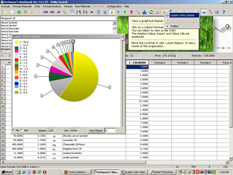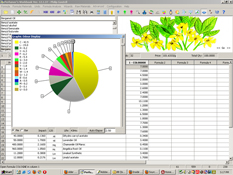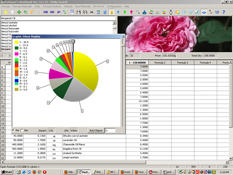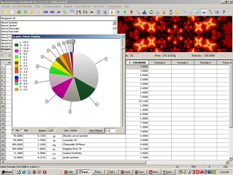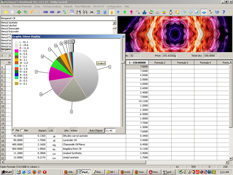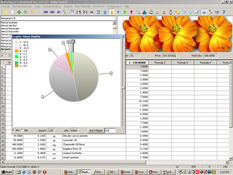The Perfumer's
Workbook® | |
Inside The Perfumer's
Workbook®
Graphic Odor Display
We continue our description of The Perfumer's Workbook with a look at the Graphic Odor Display tool. You use it by opening a formula and then clicking on the Graphic Odor Display icon on the toolbar. The Graphic Odor Display tool, which I think of as "the wheel" due to its shape and movement, displays the changing odor profile of your fragrance as it evaporates.
| The Perfumer's Workbook fragrance creation software was developed by perfumer Stephen V. Dowthwaite, founder of PerfumersWorld and is included as part of the PerfumersWorld Foundation Course or can be purchased separately for instant download.
Also available: The Perfumer's Workbook Professional Edition, starting at $5,000. Installation and on-site training available. Inquire. |
This tool can actually be used either as a pie graph or a bar graph. Both show an animated display of the evaporation process. When you load your fragrance and activate this tool it immediately shows you both the odor impact of your fragrance (in relation to the odor impact of Linalool) and the anticipated life of the fragrance on a test blotter.
These are significant metrics. If you're trying to develop a fragrance that will play well among co-workers in a crowded office, you might not want to see, for example, an odor impact of 300 as it might clear the office with Hazmat alert.
And if you notice that your fragrance is anticipated to last no more than two hours on a test blotter, you might consider adjusting your formula to bring in more base notes.
But wait. There's more to the Graphic Odor Display than these bare numbers. Click on the Auto Elapse button and it begins to evaporate your fragrance, steadily changing its display to show the change in odor profile. If, like me, you use the pie graphic display ("the wheel"), you'll see it constantly changing until all the nose can no longer smell what is left.
"Zero Hour" -- fresh out of the bottle
The display at the left shows the odor evolution of a generic cologne whose formula has been pre loaded in The Perfumer's Workbook. the top screen shot shows the odor profile of this Cologne as the oil is placed on a smelling strip, directly from the bottle. Thus the top screen shot shows our Cologne in all its glory.
The slices of the pie graph show the odor groups represented, based on The ABC's of Perfumery as developed by Steve Dowthwaite and PerfumersWorld. In this example we see a large yellow area marked "C" for "Citrus." Toggling briefly to the bar graph we see that the Citrus odor group represents 59.8 percent of the formula followed by 12.2 percent Linalool (a light, chemical aroma that commonly serves as a blender in fragrances) and then lesser percentages of Herb, Fruit, Musk ("X"), Rose, Spice, etc. This is easily understood when we look at the actual formula and see Bergamot Oil, Grapefruit Oil, Lemon Oil, Neroli Oil, and other "Citrus" (category) aroma materials. Then we wee Herb materials, Linalool, etc.
Press the "Auto Elapse" button
and evaporation begins
Once you press the "Auto Elapse" button the wheel begins to turn. What you are seeing is the rapid evaporation of the more volatile materials (the top notes of the fragrance) and, as their percentages decrease, the size of the pie slices of the less volatile materials increase.
The second screen shot shows the odor profile after 2 1/2 hours. Now Citrus is just 42.5 percent while Linalool has risen to 19.0 percent, Herb to 8.2 percent, Musk to 6.3 percent, and Fruit to 6.2 percent. Now, although Linalool, Herb, and Fruit has odor impacts about half of that of Citrus, they make up a larger portion of the odor profile and thus come into greater prominence to the nose.
After 3 hours
By the third hour, as represented by the third screen shot, we see a dramatic shift in the odor profile. Citrus ? originally the dominant note ? has faded down to just 35.5 percent of the odor profile. Linalool, Herb, Musk, and Fruit (the "middle" or "heart" notes here) continue to assume greater significance.
...and onward to the end
By 4.2 hours Citrus is down to 4.5 percent, approaching extinction .Our fragrance is now a more complex blend of Linalool, Herb, Musk, Fruit, Rose, and Green notes. We now detect smells in our fragrance that were previously masked by the dominance of Citrus.
At 11.4 hours (screen shot 5) our fragrance has lost almost all of its impact and we struggle to relate it to what first came out of the bottle.
At 24 hours (screen shot 6) we are seeing the drydown. Musk and Linalool, slightly scented by Rose, Narcotic, and a few others.When, at 43 hours, the wheel stops, nothing is left but Musk, ever so slightly scented by equally long lasting Animal ("U" for "Urine") scents, and Dairy. At the beginning, the Animal and Dairy notes were represented as tiny traces of these materials. At the end the have slightly more impact but, at the end, it is the Musk that dominates.
Hours of evaporation displayed in seconds
The Graphic Odor Display tool can be a real timesaver in evaluating your fragrance. Not only can you watch how your fragrance changes its odor profile as it evaporated, you can "stop the clock" at any point ? or set the clock to any point ? between zero hour and the last hour of its life.
The hour of the "last hour" will vary from fragrance to fragrance, depending on the aroma materials that have been used, making the evaporation cycle quite sjhort in some cases and quite long in others.
Order this fine product directly from our friends at PerfumersWorld
Homemade perfumes generally lack commercial value, regardless of how wonderful they may be, because their creators fail to record how their perfumes were made. To profit from a perfume, to sell it, to sell the rights to it, or have somebody sell it for you, you must be able to make more of it. To make more you need the formula, the record of how the perfume was made: what materials were used and how much of each material was used. While the formula is nothing more than a recipe, a simple piece of paper, it is the key to unlocking your perfume's commercial potential. With the formula in your hand you have the ability to make a few dozen bottles more or, like the celebrities, tens of thousands of bottles. How to create an international production formula for your homemade perfume is a guide to getting you started on the right foot, correctly documenting everything you do as you are doing it, and then using these notes with some basic mathematics to write a simple, accurate, universal formula for your perfume. Writing formulas for your perfumes can change the way you think about them. With your formulas in hand your creations are no longer "here today, gone tomorrow." Now, thanks to your library of formulas, your perfumes become immortal!
While much is written about perfume – the beautiful fragrances... the beautiful bottles – little is available on the "mechanics" of perfume production – the steps that take place on the "factory floor" where a beautiful vision is turned into a finished product, a "ready to sell" perfume. Now you can experience all of these steps, hands on, by making just one quart of your own perfume. If you follow each chapter and do what you are instructed to do, you will end up with from 8 to 64 bottles of your own perfume, depending on the capacity of the bottles you select. Along this "insiders journey," each step is profusely illustrated with professional color photographs and you'll learn — • Exactly what alcohol you'll need and where to get it • Why you'll want (just a little!) water in your perfume • What type bottles you'll need and why you cannot use others • Why you will use a spray and not a cap • How to fill and seal your bottles • How to label your bottles with the correct information so they will be legal for sale • How to select a name for your perfume that will allow you to acquire powerful trademark rights free. If you are a developer of scents you are encouraged to use one of your own for this project. If you are not a scent creator yourself you'll learn how to get a fragrance oil that is exactly right for this project. Online sources are given for all required supplies and materials. Nothing can hold you back from starting your project immediately!
Perfume is famous for the markup it can achieve, even for a middle market fragrance. While "everybody knows" that perfume costs next to nothing to make (not completely true) the making of it is often considered an esoteric secret. "Creating Your Own Perfume With A 1700 Percent Markup!" details how a 3-person company with no experience created their own fragrance in response to a marketing opportunity that was too good to pass up. The book explains exactly what was done to create a fragrance for that opportunity but it is far more than a history of the author's project. "Creating Your Own Perfume With A 1700 Percent Markup!" lays out every step in the process of creating your own perfume, either as a do-it-yourself project – and without the benefit of automated equipment some compromises and workarounds are required – or full bore professional production under your supervision. Either way you will be producing a quality fragrance at a remarkably low cost. Do you have a marketing opportunity that would be wildly profitable if only you could obtain your fragrance at a ridiculously low cost? "Creating Your Own Perfume With A 1700 Percent Markup!" is the guide you need to do it.
A really great name, a special name that is just right for a particular perfume or perfume marketer (or entrepreneur with money to invest!) can be worth a ton of money. But few individuals with great ideas ever manage to cash in on those brilliant ideas. Instead they wait while others "discover" their idea, acquire legal rights to it and make all the money while they are left out in the cold without a penny having been earned for what was once THEIR idea.
If you are struggling to name your perfume and are looking for a name that will have real value, "Naming Your Perfume And Protecting Your Name" will help you weed out low value names and point you to names that have better marketing value plus the potential to become valuable assets in themselves.
If you have a great name you want to protect but no fragrance, "Naming Your Perfume And Protecting Your Name" will guide you through the simple steps you must take to acquire a legal right to that name before someone else grabs it! Best of all, "Naming Your Perfume And Protecting Your Name" shows you how to gain strong legal protection for your name without a lawyer and without spending more than pocket change.
Never had an idea for a product name? Never thought much about perfume? "Naming Your Perfume And Protecting Your Name" may stimulate your interest in a whole new game that, when played well, can make you lots of money without your having to leave the comfort of your home office.
You can build a perfume business of your own using this business plan as a guide. By following its detailed strategy you learn to identify motivated groups of potential perfume buyers. Members of these groups are near the tipping point of desire for a new perfume. You don't know these people and they don't know you but you know a marketer they trust, one who does not currently sell perfume and might never think of selling perfume were it not for your approach. Here is where you step in with a professional plan, promotion, and perfume to take advantage of this ripe opportunity for mutual profit. Before your first promotion has peaked, you will already be developing a relationship with your next marketing partner. Following this plan, you will gain more and more profit with each new marketing partnership.
Now when you make your own perfume you can make it fully "commercial" meaning you will be creating a product ready for regular, continuous sales to friends, relatives, and the public! If the fragrance you've made has already won praise, why not share it with others? Some might pay you for it and want it for their web stores or retail boutiques! Creating your own perfume from dropper bottles: Methods, mechanics, and mathematics guides you through steps that can turn your hobby project into a perfume business. Discover how close you are now and how little more you must do to take what you made with essential oils and dropper bottles into a business of your own! For an introduction to this book, watch this video.
When you name a perfume you create a valuable asset – the name itself. To sell your perfume you want the most effective name possible. But a good name can have value beyond the edge it gives your sales. In naming your fragrance you are creating a trademark and a trademark can have value independent of the product. The value of that trademark can vary. Much depends on how well, in naming your perfume, you follow the trademark "rules." How To Create A More Valuable Name For Your Perfume first helps you develop a name that will be effective in selling your perfume. It then prods you to make use of certain techniques that can turn a good name into a great trademark, strong and valuable. If you have questions about how to protect a name, How To Create A More Valuable Name For Your Perfume will answer many such as:
- Can you protect your name yourself or do you need a lawyer?
- Can you register a trademark without a lawyer?
- What does it cost to register a trademark?
- How do I enforce the rights I have established?
How To Create A More Valuable Name For Your Perfume covers both state, federal, and international protection.
For article updates, etc., add your name to Phil's mailing list.


Philip Goutell
Lightyears, Inc.

